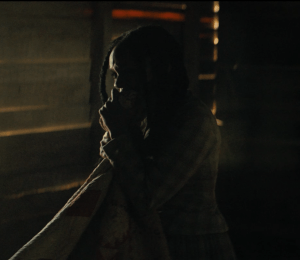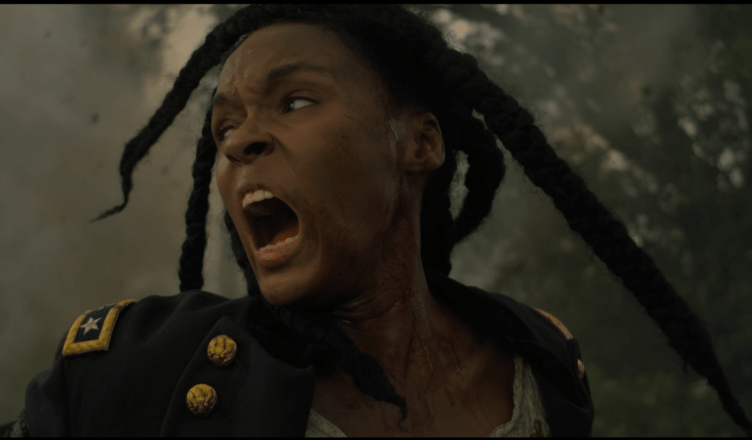Film Deets:
Director: Gerard Bush and Christopher Renz
Screenplay: Gerard Bush and Christopher Renz
Actresses: Janelle Monáe, Jena Malone
Category: Systemic White Supremacy
Themes: Enslavement, Historical Memory
Why do these screams matter?
Directed by Gerard Bush and Christopher Renz, Antebellum (2020) immediately generated controversy for its stark depictions of plantation slavery in the Antebellum South, with many viewers regarding the film as “slavery porn” (Dobbins). While Rolling Stone praised the film for offering “black audiences the escape hatch of reciprocal violence that revenge narratives deploy as a rule,” Vulture criticized its “noxious tour of historic violence against Black folks in service of a story that has nothing novel to say about the obliterating function of whiteness and anti-Black racism” (Collins; Bastién). But the film’s novel framing of the experience of enslavement, bolstered by a surprise revelation in the second act, offers a pointed critique of historical memory that is worth exploring.
Antebellum opens as a musical score crescendos against a scene of an enslaved woman trying desperately to escape. As the woman runs, an enslaved man wearing a punishment collar screams to her as he is held back by three male captors. There is a choreographed quality to the scene that is recognizable because it is a violence that has repeatedly played out on film and taps into the audience’s understanding of slavery when told through a popular cultural lens. Except for the music, the sequence is a silent one echoing how narratives of the Antebellum South have historically erased or minimized the experiences of enslaved people in favor of spectacle. The sequence ends with the capturing and killing of the enslaved woman in a moment of brutality that is especially jarring for its casualness. The film then cuts to another enslaved woman crying and crouching in fear as the General demands that she say her name. Because she is too traumatized to speak, the General then proceeds to beat and brand the woman he calls Eden (Janelle Monáe), resulting in the film’s first audible female screams.
 Stark and unrelenting, this scene forces the audience to engage with Eden’s pain by holding the camera on her face as she is branded and then discarded by the General. The viciousness of the violence, and Eden’s resulting anguish, is visceral– and ensures that the audience’s sympathies reside firmly with the enslaved people of the film. Because no space is created to view the Antebellum South as anything other than barbaric and violent, the film is a powerful rejection of the ‘genteel South’ myth. There are no picturesque panning shots of swaying magnolia trees and no domestic scenes depicting white women of wealth in acts of frivolity. Instead, the audience gets a glimpse of traditional framings of the Antebellum experience only when a white child runs up to her mother and presents a flower. However, the scene does not exist in isolation but rather moves seamlessly to the violent events that open the film. By containing these moments in one long panning shot, the film reveals the ugliness that has always existed beneath traditional depictions of the Antebellum South and places its violence on a continuum that begins with white indifference and culminates in Eden’s screams of torture. The move within this shot violates what Ewa A. Adamkiewicz refers to as white nostalgia which she defines as “an escape into constructed memories of a more glamorous, heroic past where slavery plays only a minor or no role at all” (17). Eden’s scream becomes a literal disruption to slavery narratives that whitewash the brutality and violence experienced by enslaved people.
Stark and unrelenting, this scene forces the audience to engage with Eden’s pain by holding the camera on her face as she is branded and then discarded by the General. The viciousness of the violence, and Eden’s resulting anguish, is visceral– and ensures that the audience’s sympathies reside firmly with the enslaved people of the film. Because no space is created to view the Antebellum South as anything other than barbaric and violent, the film is a powerful rejection of the ‘genteel South’ myth. There are no picturesque panning shots of swaying magnolia trees and no domestic scenes depicting white women of wealth in acts of frivolity. Instead, the audience gets a glimpse of traditional framings of the Antebellum experience only when a white child runs up to her mother and presents a flower. However, the scene does not exist in isolation but rather moves seamlessly to the violent events that open the film. By containing these moments in one long panning shot, the film reveals the ugliness that has always existed beneath traditional depictions of the Antebellum South and places its violence on a continuum that begins with white indifference and culminates in Eden’s screams of torture. The move within this shot violates what Ewa A. Adamkiewicz refers to as white nostalgia which she defines as “an escape into constructed memories of a more glamorous, heroic past where slavery plays only a minor or no role at all” (17). Eden’s scream becomes a literal disruption to slavery narratives that whitewash the brutality and violence experienced by enslaved people.
The persistence of white supremacy also factors into our second scream. Although the film at first presents itself as one situated in the historical past, the film reveals its modern setting through flashbacks that show Eden is really Veronica, a well-known sociologist who is on a press tour to talk about her new book on race and intersectionality. Here, Veronica screams for help after being abducted following a night out with her girlfriends.
The palpable fear expressed in this scream doesn’t just signal Veronica’s shock and terror at the unfolding events but also reminds the audience that the overt racism in the first act of the film is directly tied to the more subtle racism depicted in act two. Before her abduction, we see Veronica experience an array of microaggressions and covert moments of discrimination. This ensures that the audience doesn’t read Veronica’s abduction as an isolated event but as an escalation of violence that begins quietly. Veronica’s screams shatter that silence and remind audiences how rarely viewers are asked to bear witness to the pain of Black women and to consider how all of these forms of violence are directly tied to white supremacy.
Veronica’s abduction also reflects the deeply disturbing cultural apathy over the plight of missing Black women. According to numbers culled from the FBI’s National Crime Information Center database in 2021, Black women and girls make up “7% of the US population” and yet, account for “17% of missing person cases” (Mogos). Despite being in a car next to her friends who are in full party mode, Veronica’s plight is rendered invisible even in spaces shared by other women. She becomes a statistic and not a person, a point underscored later in the film when viewers learn the full extent of the enslavement taking place at the camp. And if this type of violence can befall a successful woman who has access to channels of power, what does it say for the women who lack those privileges?
The intersection of silencing and trauma is also centered in the muffled scream Veronica releases after being raped by the General.

That Veronica uses a quilt to obscure her scream is not without meaning. As Jaqueline Tobin and Raymond G. Dobard write in Hidden in Plain View: A Secret Story of Quilts, quilts were commonly coded through the use of colors, designs, and stitching to help enslaved people navigate the Underground Railroad to freedom (6). By using the quilt to stifle any outward display of emotion, Veronica is ensuring a safe space for herself to have an emotional reaction to the atrocities committed against her. The quilt provides a cover for her to connect with her rage which, in turn, fortifies her to fight another day. The moment also reminds viewers that enslaved people kept in the house were just as victimized as enslaved people forced to labor outdoors. Like Veronica, women who were kept in the home were constantly under surveillance and often lacked privacy which made preying upon them easier (“Conditions of antebellum slavery”). Her scream in this moment is a powerful demonstration of her trauma while also being a subversive renunciation of a white supremacist framework seeking to rob Veronica and women like her of their agency.
Veronica’s traumatic response moves from a subversive presentation to an overt one in our final scream set. As they attempt to escape, Veronica and Eli are discovered by the General as they attempt to enter the home to retrieve a phone.
Representing a literal and figurative unshackling, Veronica’s screams are designed to assert agency against her oppressor and to vocalize her opposition to the treatment she has endured. While certainly fueled by anger and an understanding that this may be her last shot at freedom, Veronica’s screams are a prelude to the bodily autonomy she asserts when she tells the General, “My name is Veronica.” This return to herself culminates in a final scream that closes out the film. Having survived a final battle against Elizabeth (Jena Malone), the woman who orchestrated her enslavement, Veronica begins her escape on horseback. As she passes other soldiers, she lets out a single scream.
It would be easy to frame this moment as a jubilant proclamation of freedom but that does a disservice to the complex politics informing the scene. Certainly, Veronica is expressing a guttural reaction to the circumstances she has survived, but she is also inverting the film’s opening montage. Whereas the opening used music to obfuscate the trauma of the enslaved people, this shot leverages music to provide gravitas to Veronica’s scream in an acknowledgement of what she has endured.
The final reveal that the events of the film have taken place at a Civil War reenactment park is a pointed critique of the way historical memory is commodified and often replicates harm against marginalized people. The increased interest in sites of “dark tourism” has yielded a number of ethical questions about what it means to engage with sites of human suffering (Timothy 178). Yet, Civil War memorialization events and sites have frequently steered clear of references to slavery and the horrific day-to-day realities of enslaved people of the Antebellum South. As Amanda Kennedy notes in her dissertation on race and gender relations in Civil War reenactment, “Reenactors actively avoid racial issues, as evidenced by lack of representation of slavery at reenactments, a concerted focus on historical accuracy only as it relates to material culture, and tracing the roots of the Civil War to influences other than US dependence on slavery” (16). Veronica’s culminating scream challenges this intentional erasure of Black suffering from the historical record and forces the audience to reflect on whose voices are missing when we tell the stories of the past and how that absence perpetuates white supremacy.
Works Cited
Adamkiewicz, Ewa A. “White Nostalgia: The Absence of Slavery and the Commodification of White Plantation Nostalgia.” Aspeers, no. 9, 2016, pp. 13-31.
Antebellum. Directed by Gerard Bush and Christopher Renz, performances by Janelle Monáe, Jena Malone, Kiersey Clemons and Gabourey Sidibe, Lionsgate, 2020.
Bastién, Angelica Jade. “I Am Tired of Films Like Antebellum.” Vulture, 14 Sept. 2020. Accessed 13 August 2022.
Collins, K. Austin. “Antebellum is a Revenge Fantasy Gone Sideways.” Rolling Stone, 16 Sept. 2020. Accessed 14 August 2022.
“Conditions of Antebellum Slavery.” PBS. Accessed 19 Aug. 2022.
Dobbins, April. “Antebellum Serves Up Tired Slavery Porn and Subjugation.” Miami New Times, 21 Sept. 2020.
Kennedy, Amanda Elizabeth. The Social Rules of Engagement: Race and Gender Relations in Civil War Reenactment. 2004. The Ohio State University, MA dissertation.
Mogos, Aida. “Mothers, Relatives Team Up to Raise Awareness for Missing Women.” WTTW, 8 May 2022. Accessed 18 Aug. 2022.
Timothy, Dallen J. “Making Sense of Heritage Tourism: Research Trends in a Maturing Field of Study.” Tourism Management Perspectives, no. 25, 2018, pp. 177-180.
Tobin, Jacqueline L., and Raymond G. Dobard. Hidden in Plain View: A Secret Story of Quilts and the Underground Railroad. Anchor, 2000.






